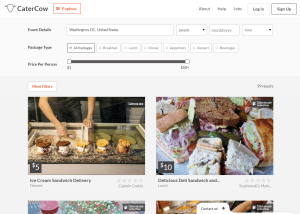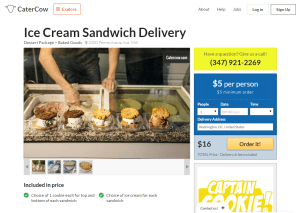Two-Sided Network Effects for a Food-Tech Marketplace

CaterCow is a food-tech startup that helps match caterers and restaurants with office managers and other customers looking to order food for meetings or events. As is typical in a two-sided market, there are both challenges to gaining traction and network effects to capitalize on once scale has been reached. Once CaterCow is able to achieve critical mass in a specific market, they are able to create significant value for both customers and partners.
Network effects can work against you until you reach critical mass; then they work for you
CaterCow has the classic chicken and egg challenges and indirect network effects (or cross-side effects) that most two-sided markets have. In order to offer customers the variety and availability that makes using CaterCow appealing, they need to achieve a critical mass of restaurant partners in a specific region. Likewise, restaurant partners are reluctant to spend energy and focus their attention on a new tool in the crowded food-tech space that doesn’t have enough customers in place to drive significant business.
Therefore, in order to get a healthy market going, it’s essential to spend the necessary time and energy to get a core group of customers ordering frequently enough to attract exciting partners. Once that critical mass is reached, however, the self-supporting flywheel of customers driving partners, driving more customers, driving more partners, etc. can take effect and allow a relatively lean team to support a robust and growing market.
CaterCow also benefits from direct network effects (or same-side effects) on the customer side. Customers have the ability to rate and review their experiences, which then feeds into the ranking and sorting for partners going forward. As a result, each customer that joins the site and leaves a review makes the next customer’s experience a little bit better by pushing good partners to the top of the list. Additionally, much like you see in other business where customers can rate their experiences, partners have an increased incentivize to provide positive service to customers, making the entire network’s experience better.
Once a market is up and running, CaterCow is able to successfully create value on both sides of the market.
Customer value creation:
- Customers gain access to a wide variety of interesting food options they might not otherwise think of
- The ability to compare similar catering packages across vendors makes the ordering process significantly easier than getting quotes from individual restaurants
- The operations team works proactively to ensure orders are delivered on-time and as-expected
Partner value creation:
- Partners gain visibility and additional business they might not otherwise get
- They only receive paid and confirmed orders, saving significant time and energy typically spent answering calls and generating quotes for customers that have a low likelihood of placing an order
- They are able to have better demand forecasting and can utilize their team and kitchens during typically idle periods
- Businesses are able to build their brand and presence through reviews and pictures
Much of their success in the face of larger, more established competitors has come from differentiation
Going head-to-head with large players, like Seamless and ezCater, in a crowded market with network effects would likely have been difficult. However, CaterCow’s focus on being small-business friendly has allowed it to differentiate itself from its competitors. They first differentiate on cost to partners, offering a rate below what larger competitors typically charge. This allows them to also differentiate on the types of partners they can add, attracting smaller, more unique offerings that are often not available through other services.
Network effects could allow CaterCow to capture additional value from both new and existing channels
If they chose to, CaterCow could leverage the strength of their network to charge higher rates to new partners that join to take advantage of the steady stream of customers ordering on the site. However, given their focus on being small-business friendly, they are unlikely to do so. They are far more likely to pursue additional revenue streams in ways that simultaneously create and capture new value. On the customer side, they could consider adding premium features such as fully-managed catering, allowing customers to sign up for recurring meals with certain parameters and having CaterCow place an order and manage the process from end-to-end. On the partner side, CaterCow could offer to list a few “sponsored packages” at the top of search results, much like Google, Yelp, and other search services, to allow partners to promote packages and drive additional business.






Certainly an interesting business model and definitely one that has strong network effects / scale advantages. I’m curious to what extent the company has experienced churn related to customers dropping off the Cater Cow network once they’ve had positive experiences with a given caterer..that is a small business decides to just reach out directly to a caterer (or 2-3) of choice going forward. My sense is the premium features around “fully-managed catering” / managing the order up to delivery are creative additions to mitigate this risk. I’d be curious to hear what else Cater Cow is doing to try to add value to the ordering process and further connect customers with their platform.
Very interesting! You mention that CaterCow has been able to differentiate themselves from larger players such as Seamless and exCater by being very small business friendly. I wonder if this strategy has worked so far because the larger companies have not tried very hard in this niche. I am a little concerned that there will be a lot of multihoming if the larger companies do attack in a significant way, and because of the prevalence of Seamless for example in other delivery jobs, users will be more willing to switch platforms.